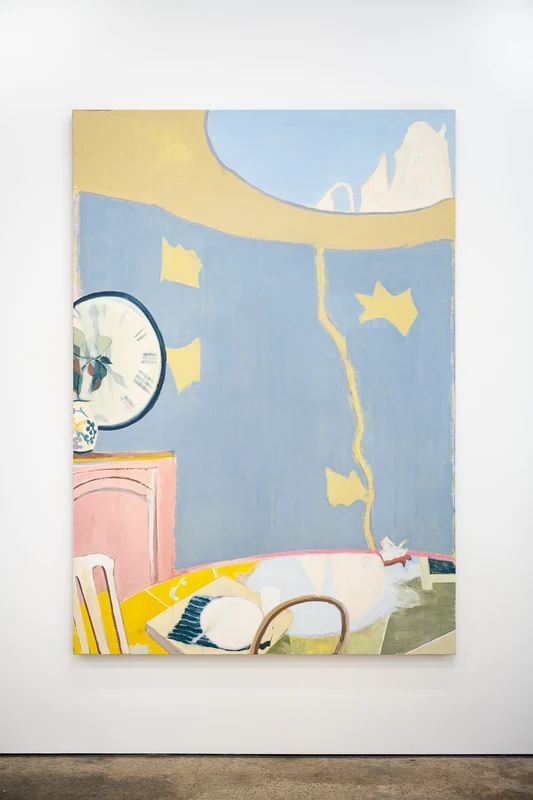‘After Images’ by Dan Linden
18 Sep-13 Nov 2021
PV 18 Sep 2021, 12-6pm


By appointment only from 23 Oct to 13 Nov 2021.
Claas Reiss is pleased to announce ‘After Images’ with new paintings by British artist Dan Linden in his first solo show and an essay written by Nicola Stephanie.
The following conversation between Dan Linden and Nicola Stephanie was transcribed in the period leading up to Linden’s upcoming exhibition at Claas Reiss.
The two artists, who studied together at Hunter College in New York City, expand on themes suggested by the title, which can be taken at least three ways. First, it refers to an optical trace or visual remnant, as when looking intensely at an object and then closing the eyes. Second, it indicates the importance of delay, implying that Linden’s images come after some prior event, which nonetheless remains unspecified. Finally, the title alludes to art history as a backdrop and source (as when a picture is denoted as being made “after” another artist).
What these dynamics have in common is a certain strategic indirection - “a tumbling of images and thoughts that are often seeking some sort of solace,” as Linden puts it - hinting at new possibilities for the medium of painting.
***
NS: I want to ask you about absence. Your paintings seem to ask how certain we can be of what we’re seeing. Scenes are fragmented; objects half described by surrounding space; planes repainted translucently to leave barely discernible impressions of earlier compositions. To me this suggests the possibility for a kind of absence or displacement in what is depicted.
DL: What I’m looking for is quite a loose connection to the real world - a desire to create an image that might exist on a psychological plane. Starting from a particular place, but then through the process of painting de-familiarising myself with the initial memory. Working with negative space, covering, obscuring. I hope to depict the process of recollecting as opposed to the memory itself.
NS: Do the memories relate to particular events, or is it less autobiographical than that?
DL: I think the paintings rarely relate to a specific event. It’s more an accumulation of glimpses. At the same time there are often certain found images I have accumulated over the years, which might be hovering around, as well as particular paintings by other artists I am thinking about. These form a sort of reservoir of images and every now and then something floats to the surface.
NS: I wonder what you mean by “found images” in this context, and how you’re making decisions around what to include, as I don't think you use chance compositional procedures. How do the found images relate to the other elements in the painting?
DL: This is the hardest thing for me to talk about as it's the most intuitive part of the process. Sometimes it is a formal choice. In other instances, there is an association, for example, Ebb Tide began with a memory of a walk along the river in London. The factory is from a book of black and white photographs of London by night. The water became a point of connection.
NS: It constructs an echo - layers of urban histories linked by the image of flowing water. Do you want the found images to be identifiable as found images?
DL: I’ve been working towards a way of stitching images together that feels more seamless, as I became dissatisfied with the rupture created by collage. I’m interested in how the found images or film stills might impinge or coexist with the more familiar places that the paintings depict. So often we are unaware of our immediate surroundings, drifting, thinking about the past or the future. It’s the sort of daydreaming experience that I have mostly experienced reading novels but hope to evoke in paint.
NS: I’ve been thinking about how I experience images in my mind’s eye. Rather than being overlaid into the present visual field, they seem more like a separate and concurrent channel of visual experience. Images without edges.
DL: I relate to that idea of memory. I think this is why so often there are thresholds in my paintings, windows or mirrors that hint at other spaces and frustrate your attempt to see something clearly. Certain parts of the paintings remain easily recognisable whist other elements are barely painted or dissolve away. I think paint has a wonderful ability to capture the amorphous, cloudy nature of memory.
NS: My iPad suggests daily ‘memories’ to me in randomly selected photos. I used to ignore them but recently have been curious. On one level it’s nice to look and be reminded, but I worry they could replace other memories already in my head. Do you think your work reflects a kind of anxiety around erasure, perhaps more to do with the relationship between places and their histories, rather than the digital?
DL: I am interested in evoking more broadly the mind’s habit of jumping from one idea to the next. I have learnt to observe these thoughts, noticing how one leads to another in such a random way. A tumbling of images and thoughts that are often seeking some sort of solace. I am so unaware of my immediate surroundings during such times, these thoughts become more real than my actual experience.
***
Dan Linden (born 1989 in UK) graduated with First Class (BA Hons) Fine Art from Newcastle University in 2013 and MFA Fine Art from Slade School of Fine Art, London in 2021. He also studied at Universität für Angewandte Kunst in Vienna, Austria, as an Erasmus exchange student and at Hunter College in New York City, USA under Carrie Moyer. Dan was included in Saatchi’s New Sensations group show in 2013 and London Grads Now in 2020. ‘After Images’ at Claas Reiss is Dan’s first gallery solo show. Dan lives and works in London, UK.